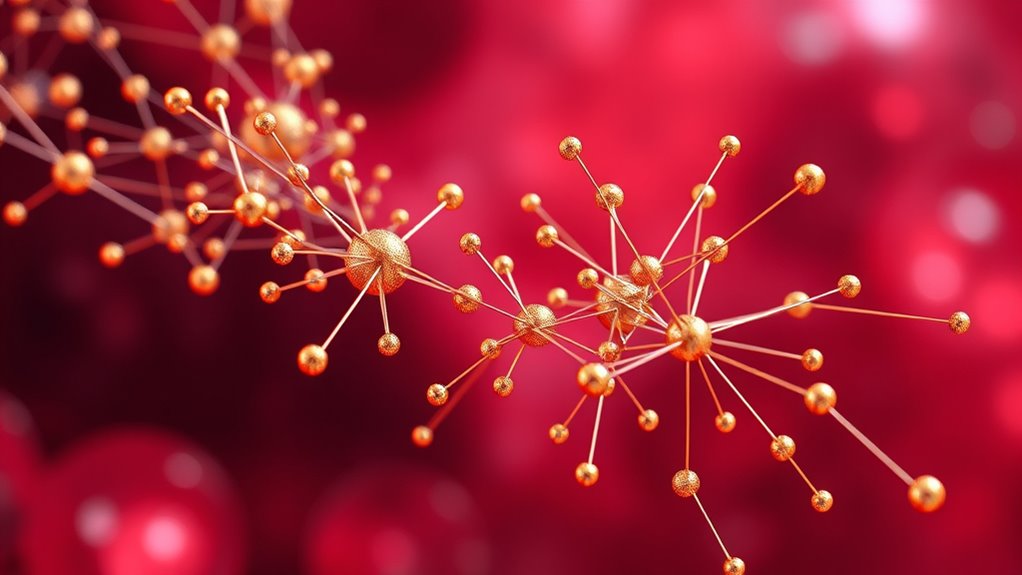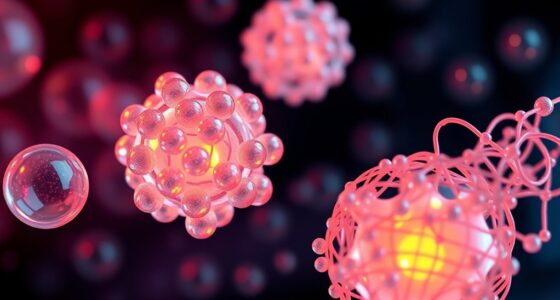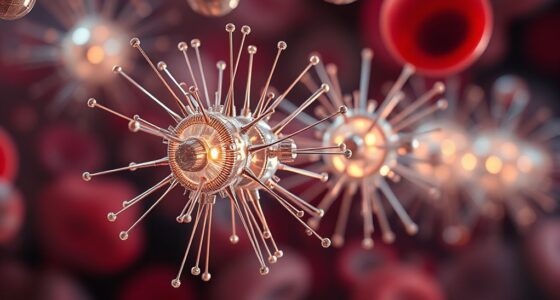Nanotechnology is transforming cardiovascular therapy by enabling precise diagnosis, targeted drug delivery, and tissue regeneration. It allows you to detect heart conditions early with advanced imaging and nanoparticles that improve sensitivity. Nanosystems deliver medications directly to affected areas, reducing side effects and boosting treatment effectiveness. Innovations like nanostructured stents support tissue growth and healing. To discover how these advances are shaping future heart care, explore the detailed innovations and challenges ahead.
Key Takeaways
- Nanoparticles enable targeted delivery of drugs and therapeutics to damaged heart tissues, improving treatment efficacy.
- Nanotechnology enhances early diagnosis and real-time imaging of cardiovascular diseases through advanced nanoparticles and nanosensors.
- Nanoscale scaffolds and nanostructured implants promote tissue regeneration and reduce restenosis in cardiac repair.
- Targeted nanotherapies minimize systemic side effects and toxicity by delivering medications precisely to affected areas.
- Emerging nanomaterials and nanodevices facilitate personalized, smart cardiovascular treatments with improved safety and diagnostic capabilities.
The Role of Nanotechnology in Cardiac Disease Diagnosis
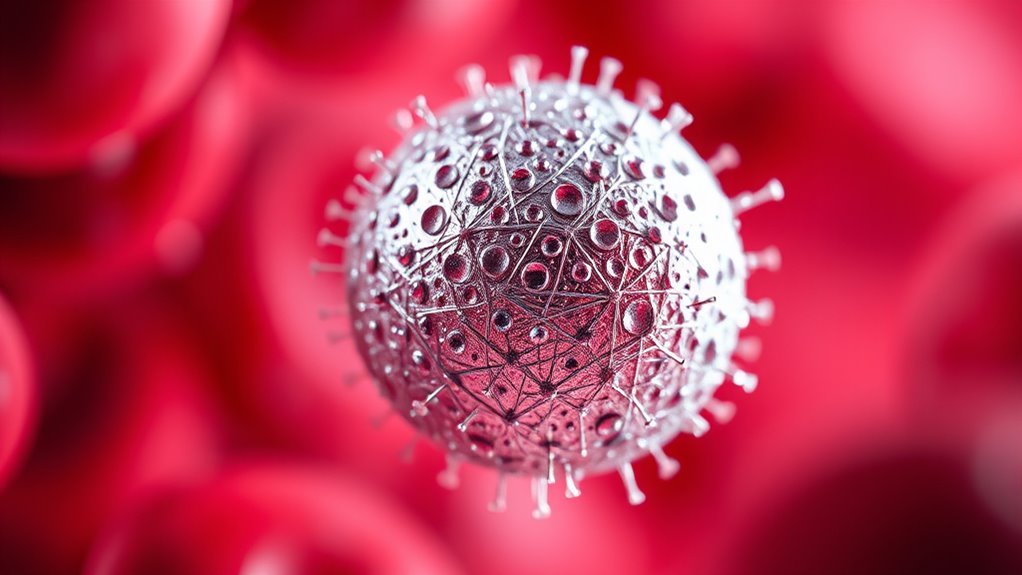
Nanotechnology is transforming how we diagnose cardiac diseases by enabling highly sensitive and precise detection methods. One key advancement is nanoparticle synthesis, which produces particles tailored for specific biomedical applications. These nanoparticles can be engineered to bind selectively to cardiac biomarkers, making detection more accurate. When you use nanotechnology for cardiac biomarker detection, you benefit from rapid, early diagnosis of heart conditions. The unique properties of nanoparticles, such as their large surface area and customizable surface chemistry, enhance sensitivity and reduce false positives. This technology allows you to identify subtle changes in biomarker levels that traditional methods might miss. Additionally, the integration of nanotechnology with diagnostic tools can further improve detection capabilities. As a result, nanotechnology offers a powerful tool to improve diagnostic accuracy, enabling earlier intervention and better patient outcomes.
Targeted Drug Delivery Systems for Heart Conditions

Targeted drug delivery systems let you direct medication precisely to affected heart tissues, improving treatment effectiveness. This focus enhances targeting accuracy, ensuring drugs reach the right spots while minimizing impact elsewhere. As a result, you experience fewer side effects and better overall outcomes.
Enhanced Targeting Precision
Advancements in nanotechnology have considerably improved the precision of drug delivery systems for heart conditions. You now benefit from nanosensors that detect specific biomarkers, allowing targeted therapy. Quantum dots further enhance this precision by illuminating affected areas, guiding treatments exactly where needed. These tools enable you to focus drugs directly on diseased tissues, reducing off-target effects. The table below highlights how these technologies work together:
| Technology | Function |
|---|---|
| Quantum dots | Visualize and locate damaged tissue |
| Nanosensors | Detect biomarkers in real-time |
| Targeted drugs | Deliver medication precisely |
This synergy ensures your therapy is more effective, with minimized risks and improved outcomes. Enhanced targeting means your treatment is sharper, smarter, and tailored to your heart’s specific needs.
Reduced Side Effects
By delivering drugs directly to affected heart tissues, targeted drug delivery systems considerably reduce side effects associated with traditional treatments. This precision minimizes drug toxicity by preventing unnecessary exposure to healthy tissues, thereby lowering the risk of adverse reactions. With nanotechnology-based carriers, you can achieve more effective control over drug release, reducing the overall dosage needed. As a result, you experience fewer side effects, making treatments more tolerable and safer. This targeted approach not only enhances therapeutic outcomes but also minimizes the potential for systemic toxicity. By focusing medication precisely where it’s needed, you benefit from significant side effect reduction, improving your overall treatment experience and quality of life.
Nanomaterials for Cardiac Tissue Regeneration

Nanomaterials have emerged as powerful tools for cardiac tissue regeneration, offering innovative solutions to repair damaged heart muscle. Their high surface area and unique properties enable the development of effective cardiac tissue scaffolds that support cell growth and integration. When designing these scaffolds, nanomaterial biocompatibility is vital to guarantee they do not provoke adverse immune responses or toxicity. By carefully selecting biocompatible nanomaterials, you can create scaffolds that mimic the natural extracellular matrix, promoting tissue regeneration and functional recovery. These nanomaterials can also deliver growth factors or drugs directly to the damaged site, enhancing healing. Additionally, understanding nanomaterial properties is essential for optimizing their performance in regenerative applications. Overall, integrating nanomaterials into cardiac tissue engineering holds great promise for restoring heart function with minimal complications.
Enhancing Imaging Techniques With Nanotechnology
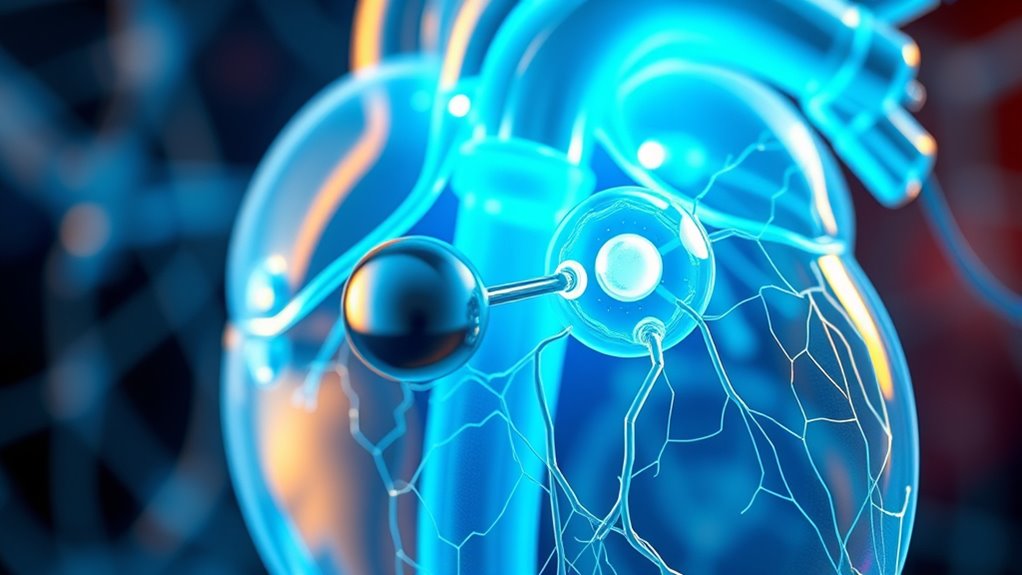
Nanotechnology has markedly improved imaging techniques used in cardiovascular diagnosis and treatment. Quantum dots, with their bright fluorescence and stability, enable highly precise imaging of blood vessels and heart tissue, revealing details previously hard to visualize. These nanoscale particles can target specific cells or molecules, providing real-time, high-resolution images. Nanosensors further enhance imaging by detecting biochemical changes within the cardiovascular system, such as inflammation or oxidative stress. They can be integrated into imaging devices to deliver immediate feedback, improving diagnostic accuracy. By combining quantum dots and nanosensors, you gain access to more detailed, specific, and dynamic imaging, which supports early detection and better monitoring of cardiovascular conditions. This nanotechnology-driven approach ultimately leads to more effective and personalized treatments. Additionally, advancements in AI-enabled imaging techniques are further enhancing the precision and speed of cardiovascular diagnostics, paving the way for smarter healthcare solutions.
Nanoparticles in Managing Atherosclerosis

Nanoparticles offer promising solutions for managing atherosclerosis by enabling targeted drug delivery directly to plaque sites. They also improve plaque imaging techniques, allowing for more precise detection and assessment. Together, these advancements can enhance treatment effectiveness and patient outcomes. Additionally, the integration of advanced imaging technologies with nanoparticle delivery systems holds potential for even more accurate diagnosis and monitoring of cardiovascular conditions.
Targeted Drug Delivery
Targeted drug delivery using nanoparticles offers a promising approach to treat atherosclerosis more effectively. You benefit from enhanced nanoparticle stability, which guarantees the therapeutic agents remain intact until reaching the target site. Surface modification plays a vital role in this process, allowing you to attach specific ligands or molecules that recognize and bind to diseased arteries. This precision minimizes off-target effects and maximizes drug efficacy. By customizing surface properties, you can improve nanoparticle circulation time and reduce immune clearance. As a result, the delivery of drugs directly to plaque sites becomes more efficient, reducing side effects and increasing treatment success. Overall, surface-modified nanoparticles represent a sophisticated tool for precise, controlled, and effective management of atherosclerosis.
Plaque Imaging Techniques
Because early and accurate detection of atherosclerotic plaques is essential for effective treatment, advanced imaging techniques utilizing nanoparticles have emerged as powerful tools. These nanoparticles enhance contrast and enable precise visualization of plaque composition and stability. However, biocompatibility challenges remain, as ensuring nanoparticles do not provoke adverse immune responses is critical. Additionally, regulatory hurdles slow the translation of these technologies into clinical practice, requiring extensive safety and efficacy data. Overcoming biocompatibility issues involves developing materials that are both effective and safe for human use. Steering regulatory pathways demands rigorous testing and validation, which can delay widespread adoption. Despite these challenges, nanoparticle-based plaque imaging holds great promise for improving diagnosis, guiding interventions, and ultimately reducing cardiovascular events.
Reducing Side Effects Through Nano-Enabled Therapies
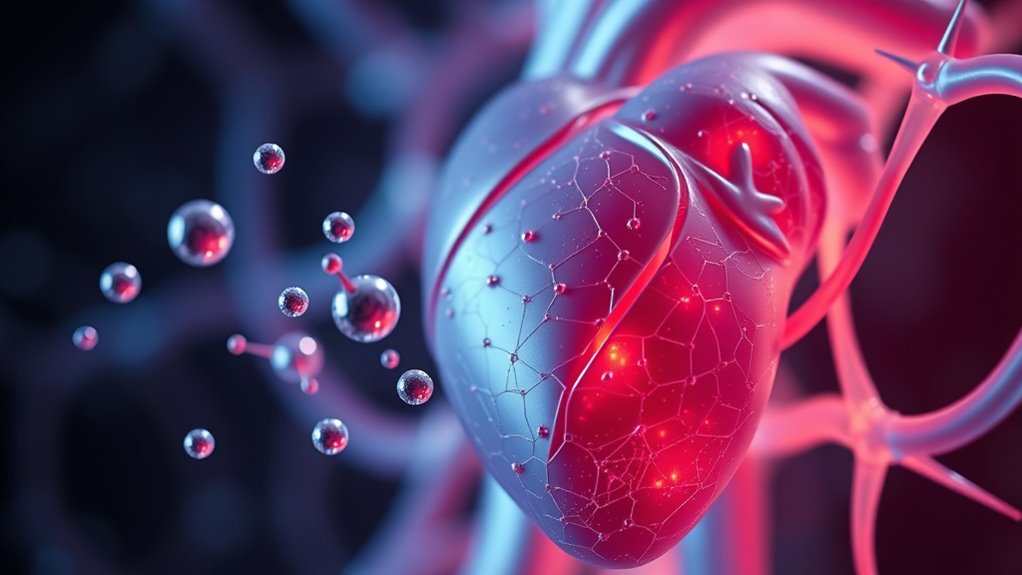
Nanotechnology offers a promising approach to minimize side effects in cardiovascular therapy by enhancing drug delivery precision. By targeting specific tissues, nano-enabled therapies reduce drug exposure to healthy cells, lowering risks like nanoparticle toxicity. However, you should consider ethical considerations, such as long-term safety and environmental impact. Here are four ways nano-therapies help reduce side effects:
- Precise targeting minimizes off-target effects.
- Controlled drug release reduces dosage frequency.
- Lower systemic exposure lessens toxicity.
- Improved biocompatibility enhances safety profiles.
Additionally, ongoing research into nanoparticle toxicity is crucial to fully understand and mitigate potential risks associated with nano-enabled treatments. Despite these benefits, you must remain cautious about nanoparticle toxicity and ensure ethical standards are met. Proper testing and regulation are essential for safe, effective implementation of nano-enabled cardiovascular treatments.
Innovations in Nanostructured Stents and Implants

Building on advancements in nano-enabled drug delivery, researchers have turned to nanostructured stents and implants to improve cardiovascular interventions. Through nanostructure fabrication, they create surfaces with controlled topographies that promote better tissue integration and reduce restenosis. Surface modification techniques enable the attachment of bioactive molecules, enhancing biocompatibility and preventing clot formation. These innovations allow for more precise control over cell responses, encouraging endothelialization while minimizing inflammation. By tailoring nanostructures, you can improve mechanical properties and durability of implants. This approach also facilitates localized drug release, providing targeted therapy directly at the site. Overall, nanostructured stents and implants represent a significant leap forward, offering safer, more effective options for cardiovascular treatment and patient recovery.
Challenges and Safety Considerations in Cardiac Nanomedicine

Despite the promising advances in cardiac nanomedicine, numerous challenges and safety concerns must be addressed before widespread clinical adoption. First, biocompatibility concerns remain critical; nanoparticles may trigger immune responses or toxicity. Second, potential long-term effects are unknown, raising safety questions. Third, regulatory hurdles complicate approval processes, as nanomedicine applications often lack clear guidelines. Fourth, manufacturing consistency and quality control pose challenges for large-scale, safe production. Addressing these issues is essential to guarantee patient safety and clinical efficacy. Overcoming biocompatibility concerns and steering regulatory hurdles require rigorous testing and collaboration with authorities. Additionally, establishing standardized testing protocols is vital for assessing nanoparticle safety and efficacy consistently across studies. Only then can nanotechnology reach its full potential in transforming cardiovascular therapy safely.
Future Perspectives and Emerging Trends in Cardio-Nanotechnology

As research advances, the future of cardio-nanotechnology looks promising, driven by emerging trends that aim to enhance therapeutic precision and safety. Quantum dots and nanosensors are at the forefront, enabling real-time monitoring and targeted interventions. Quantum dots offer improved imaging for early detection, while nanosensors can detect subtle biochemical changes in cardiovascular tissues. These innovations will likely improve personalized treatment, reduce side effects, and facilitate early diagnosis. The integration of smart nanodevices will enable you to track disease progression and response to therapy more accurately. As shown below, these trends are shaping a more precise and safer cardiovascular care landscape: targeted nanotherapies offer promising avenues for customized treatment approaches.
Case Studies Highlighting Nanotech Advancements in Cardiology
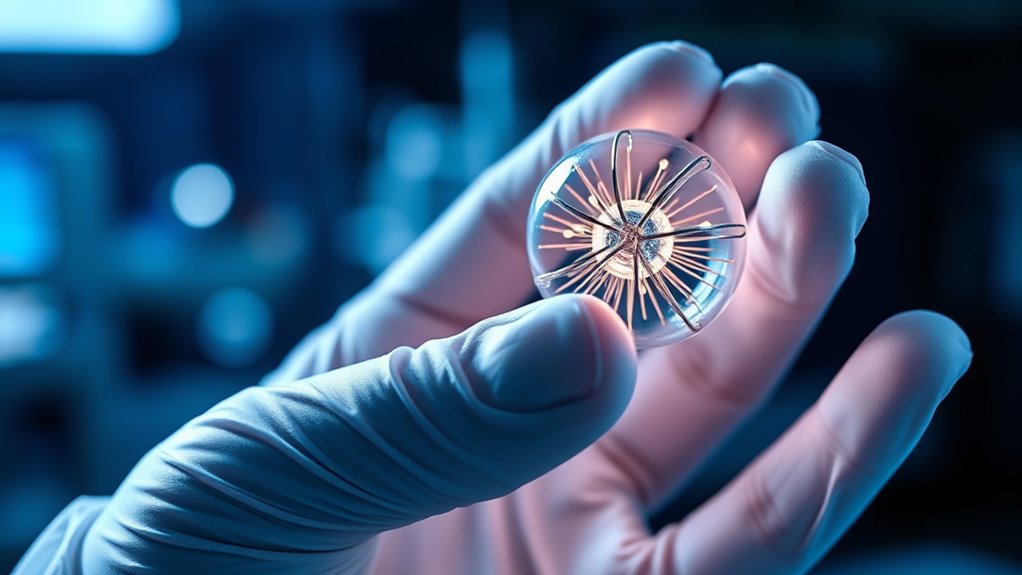
Recent case studies demonstrate how nanotechnology is transforming cardiology by providing targeted, minimally invasive solutions. For example, researchers successfully used nanoparticle-based drug delivery to treat atherosclerosis, reducing side effects and improving outcomes. Another study highlights nanotech’s role in repairing damaged heart tissue with nanofibers that mimic natural myocardium. Additionally, ongoing research emphasizes the importance of regulatory frameworks to ensure safe and effective clinical applications. However, nanotech ethics and regulatory hurdles remain challenges, as safety and long-term effects are still under review.
Frequently Asked Questions
What Are the Long-Term Effects of Nanomaterials in Cardiac Treatments?
You might wonder about the long-term effects of nanomaterials in cardiac treatments. While biocompatibility studies suggest they are generally safe, ongoing research is needed to understand potential risks. You should also consider their environmental impact, as nanomaterials could accumulate or cause unforeseen effects over time. Staying informed about advances and safety assessments helps guarantee these innovations benefit your health without unintended consequences.
How Cost-Effective Are Nanotechnology-Based Therapies for Widespread Cardiac Care?
This breakthrough could revolutionize healthcare, making nanotechnology-based therapies incredibly cost-effective. You’ll find that a thorough cost analysis shows these treatments could lower long-term expenses by reducing hospital stays and invasive procedures. While initial investments are high, healthcare economics suggest widespread adoption will eventually lower costs and improve accessibility. You’re looking at a future where advanced cardiac care becomes affordable, transforming patient outcomes globally.
Are There Ethical Concerns Surrounding the Use of Nanotechnology in Medicine?
You should consider that ethical concerns with nanotechnology in medicine include protecting patient privacy, as sensitive data might be vulnerable. Additionally, you need to think about the environmental impact, since nanoparticles could pose risks if they enter ecosystems. Ensuring responsible development and use of nanotech helps address these issues, safeguarding both individual rights and the planet while advancing medical innovation.
How Do Nanomaterials Interact With Immune System Responses in the Heart?
You should know that nanomaterials can modulate immune responses in the heart by influencing immune cell activity, which affects inflammatory responses. When introduced, they may either trigger inflammation or help suppress it, depending on their design. This interaction is vital because effective immune modulation can reduce tissue damage and improve healing. However, understanding these responses is necessary to guarantee safety and maximize therapeutic benefits in cardiovascular treatments.
What Regulatory Challenges Exist for Approving Nanotechnology Devices in Cardiology?
You face regulatory challenges like ensuring regulatory approval and meeting safety standards for nanotechnology devices in cardiology. Authorities require extensive testing to demonstrate safety and efficacy, which can be complex due to the unique properties of nanomaterials. Managing these regulations demands thorough documentation and compliance with evolving guidelines, making the approval process lengthy. Staying updated on regulatory policies helps you address these challenges efficiently and bring innovative nanotech solutions to patients safely.
Conclusion
As you explore nanotechnology’s role in cardiovascular therapy, remember that innovation is key to better outcomes. With ongoing advancements, you can expect more precise diagnostics, targeted treatments, and improved recovery options. Embrace these cutting-edge solutions, but also stay mindful of safety. After all, Rome wasn’t built in a day—patience and careful progress will lead to a healthier future for cardiac care through nanotechnology.
